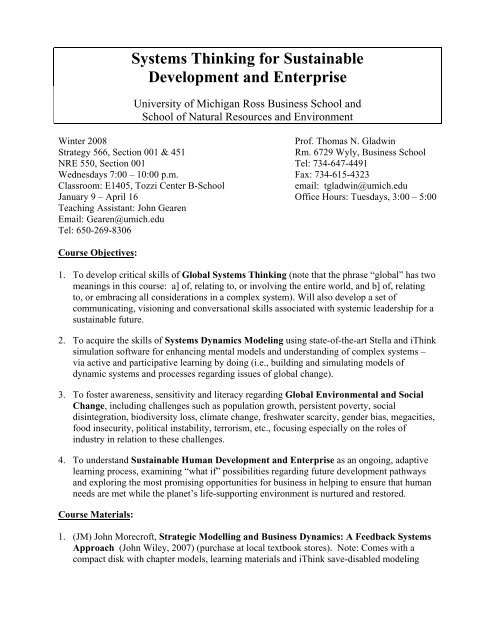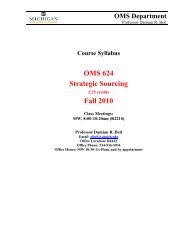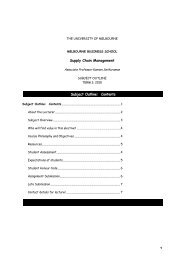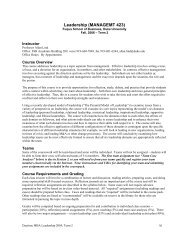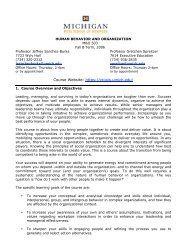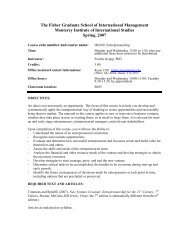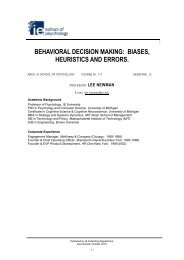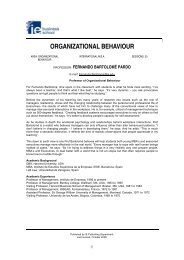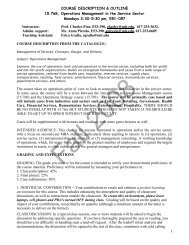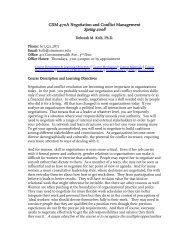Systems Thinking for Sustainable Development and Enterprise
Systems Thinking for Sustainable Development and Enterprise
Systems Thinking for Sustainable Development and Enterprise
You also want an ePaper? Increase the reach of your titles
YUMPU automatically turns print PDFs into web optimized ePapers that Google loves.
<strong>Systems</strong> <strong>Thinking</strong> <strong>for</strong> <strong>Sustainable</strong><br />
<strong>Development</strong> <strong>and</strong> <strong>Enterprise</strong><br />
University of Michigan Ross Business School <strong>and</strong><br />
School of Natural Resources <strong>and</strong> Environment<br />
Winter 2008<br />
Prof. Thomas N. Gladwin<br />
Strategy 566, Section 001 & 451<br />
Rm. 6729 Wyly, Business School<br />
NRE 550, Section 001 Tel: 734-647-4491<br />
Wednesdays 7:00 – 10:00 p.m. Fax: 734-615-4323<br />
Classroom: E1405, Tozzi Center B-School<br />
email: tgladwin@umich.edu<br />
January 9 – April 16 Office Hours: Tuesdays, 3:00 – 5:00<br />
Teaching Assistant: John Gearen<br />
Email: Gearen@umich.edu<br />
Tel: 650-269-8306<br />
Course Objectives:<br />
1. To develop critical skills of Global <strong>Systems</strong> <strong>Thinking</strong> (note that the phrase “global” has two<br />
meanings in this course: a] of, relating to, or involving the entire world, <strong>and</strong> b] of, relating<br />
to, or embracing all considerations in a complex system). Will also develop a set of<br />
communicating, visioning <strong>and</strong> conversational skills associated with systemic leadership <strong>for</strong> a<br />
sustainable future.<br />
2. To acquire the skills of <strong>Systems</strong> Dynamics Modeling using state-of-the-art Stella <strong>and</strong> iThink<br />
simulation software <strong>for</strong> enhancing mental models <strong>and</strong> underst<strong>and</strong>ing of complex systems –<br />
via active <strong>and</strong> participative learning by doing (i.e., building <strong>and</strong> simulating models of<br />
dynamic systems <strong>and</strong> processes regarding issues of global change).<br />
3. To foster awareness, sensitivity <strong>and</strong> literacy regarding Global Environmental <strong>and</strong> Social<br />
Change, including challenges such as population growth, persistent poverty, social<br />
disintegration, biodiversity loss, climate change, freshwater scarcity, gender bias, megacities,<br />
food insecurity, political instability, terrorism, etc., focusing especially on the roles of<br />
industry in relation to these challenges.<br />
4. To underst<strong>and</strong> <strong>Sustainable</strong> Human <strong>Development</strong> <strong>and</strong> <strong>Enterprise</strong> as an ongoing, adaptive<br />
learning process, examining “what if” possibilities regarding future development pathways<br />
<strong>and</strong> exploring the most promising opportunities <strong>for</strong> business in helping to ensure that human<br />
needs are met while the planet’s life-supporting environment is nurtured <strong>and</strong> restored.<br />
Course Materials:<br />
1. (JM) John Morecroft, Strategic Modelling <strong>and</strong> Business Dynamics: A Feedback <strong>Systems</strong><br />
Approach (John Wiley, 2007) (purchase at local textbook stores). Note: Comes with a<br />
compact disk with chapter models, learning materials <strong>and</strong> iThink save-disabled modeling
software. [NOTE***Apparently out-of-print until late January…we’ll scan copies of early<br />
chapters!!!!!!!].<br />
2. STELLA Version 9.0/Student (Windows or Mac) systems dynamics software (order from<br />
iseesystems at www.iseesystems.com , info@iseesystems.com , Phone: 603-448-4990, Tollfree:800-987-6758,<br />
Fax: 603-448-4992. I’ll be providing iseesystems with the class roster<br />
<strong>for</strong> confirmations right after the first class. Perpetual License is $129; 6 Month License is<br />
$59. [NOTE: may want to share this software; will first use in class on Jan. 30).<br />
3. Other assorted readings, cases, h<strong>and</strong>outs, psychographs, etc. to be posted on course tools site,<br />
distributed in class or downloaded from the web.<br />
Student Per<strong>for</strong>mance Evaluation:<br />
1. (20%) Class Participation Throughout (including topic teammate evaluations <strong>for</strong> team<br />
reports below).<br />
2. (20%) Global Change Topic Team Expert Report (due Feb. 6) (a detailed report on<br />
your selected global change topic including definitions, indicators, data sources, trends,<br />
geographical patterns, primary determinants, primary consequences, role of industry,<br />
implications <strong>for</strong> sustainability, prior modeling ef<strong>for</strong>ts, simple causal looping, etc. –<br />
guidelines <strong>for</strong> report to be provided).<br />
3. (20%) Topic Team Model Building Report (due March 5) (an individual topic team<br />
Stella model building ef<strong>for</strong>t converting causal looping from the prior Expert Report into a<br />
relatively simple Stella dynamic model to acquire the basics of Stella modeling—<br />
guidelines <strong>for</strong> report to be provided).<br />
4. (20%) Dyad Team Model Building Report One (due March 26) (“r<strong>and</strong>om” uniting of<br />
two global change topic teams [e.g., poverty <strong>and</strong> population] to build <strong>and</strong> simulate a<br />
dynamic Stella model connecting the two topics--united teams will follow four stages of<br />
model construction: conceptualization, <strong>for</strong>mulation, testing <strong>and</strong> implementation-- results<br />
to be presented in class emphasizing implications <strong>for</strong> industry <strong>and</strong> sustainable<br />
development—guidelines <strong>for</strong> report to be provided.)<br />
5. (20%) Dyad Team Model Building Report Two (due April 16) (a second “r<strong>and</strong>om”<br />
uniting of two global change topic teams [e.g., climate stability <strong>and</strong> biodiversity] building<br />
<strong>and</strong> simulating a dynamic model connecting the two topics – same process as above).<br />
<strong>Systems</strong> Dynamics, <strong>Thinking</strong> <strong>and</strong> Sustainability Websites:<br />
1. Sastry <strong>and</strong> Sterman, “Desert Isl<strong>and</strong> Dynamics: An Annotated Survey of the Essential<br />
<strong>Systems</strong> Dynamics Literature,” (1992) (at www.web.mit.edu/jsterman/www/DID.html)<br />
2. The Sustainability Institute (at www.sustainer.org).<br />
3. Forum on Science <strong>and</strong> Technology <strong>for</strong> Sustainability (at www.sustsci.harvard.edu).<br />
4. World Business Council on <strong>Sustainable</strong> <strong>Development</strong> (at www.wbscd.org)<br />
2
5. International Council <strong>for</strong> Science (at www.icgu.org).<br />
6. United Nations Population Fund (at www.unfpa.org).<br />
7. Rocky Mountain Institute (at www.rmi.org).<br />
8. SustainAbility Ltd (at www.sustainability.com).<br />
9. Stockholm Environmental Institute (at www.tellus.org).<br />
10. International Forum on Globalization (at www.ifg.org).<br />
11. Natural Capitalism (at www.natcap.org).<br />
12. Turning Point Project (at www.turnpoint.org).<br />
13. The World Bank (at www.worldbank.org ).<br />
14. Worldwatch Institute (at www.worldwatch.org).<br />
15. United Nations <strong>Development</strong> Programme (at www.undp.org).<br />
16. Friends of the Earth (at www.foe.org).<br />
17. Greenpeace (at www.greenpeace.org).<br />
18. Third World Network (at www.twnside.org.sg).<br />
19. United Nations <strong>Development</strong> Fund <strong>for</strong> Women (at www.undp.org/unifem).<br />
20. Foreign Affairs (at www.<strong>for</strong>eignaffairs.org).<br />
21. Foreign Policy (at www.<strong>for</strong>eignpolicy.com ).<br />
22. Tomorrow Magazine ( at www.tomorrow-web.com).<br />
23. Tom Fiddaman’s System Dynamics Bookmarks (at<br />
www.home.earth.net/~tomfid/sdbookmarks.html).<br />
24. <strong>Systems</strong> Dynamics Society (at www.albany.edu/cpr/sds/).<br />
25. Complexity, Complex <strong>Systems</strong> & Chaos Theory Website (at<br />
www.brint.com/systems.htm).<br />
26. Pegasus Publishers (at www.pegasuscom.com).<br />
27. Isl<strong>and</strong> Press (at www.isl<strong>and</strong>press.org).<br />
28. <strong>Systems</strong> Dynamics Group at MIT (at www.sysdyn.mit.edu).<br />
29. World Game Institute (at www.worldgame.org).<br />
30. Beijer International Institute of Ecological Economics (at www.beijer.kva.se).<br />
31. Atkisson Inc. Sustainability Consulting (at www.atkisson.com).<br />
32. Conservation Ecology (at www.consecol.org).<br />
33. Santa Fe Institute (at www.santafe.org).<br />
34. World Resources Institute (at www.wri.org).<br />
35. The <strong>Systems</strong> Thinker (at www.thesystemsthinker.com).<br />
36. Center <strong>for</strong> Health <strong>and</strong> the Global Environment, Harvard Medical School (at<br />
www.med.harvard.edu/chge/).<br />
37. Environmental Sustainability In<strong>for</strong>mation (www.environmentalsustainability.info/)<br />
38. Woodrow Wilson International Center <strong>for</strong> Scholars—Global Environmental Change <strong>and</strong><br />
Security Program (at www.wwics.si.edu).<br />
39. The National Endowment <strong>for</strong> Democracy (at www.ned.org).<br />
40. Freedom House (at www.freedomhouse.org).<br />
41. <strong>Systems</strong> Links by Bill Brawn (at www.hlthsys.com/pub/systems.htm).<br />
42. <strong>Systems</strong> Dynamics/<strong>Systems</strong> <strong>Thinking</strong> Mega-Link-List (at www.uniklu.act.at/~gossimit/linklist.php).<br />
43. Resource Links on Self-Organization, Complexity <strong>and</strong> Artificial Life (at<br />
www.calresco.org/links).<br />
44. The Resilience Alliance (at www.resalliance.org).<br />
3
45. The International Dimensions Programme on Global Environmental Change (at<br />
www.ihdp.org).<br />
46. Theories <strong>for</strong> <strong>Sustainable</strong> Futures (at www.sustainablefutures.net).<br />
47. Center <strong>for</strong> International Earth Science In<strong>for</strong>mation Network (at<br />
www.ciesin.columbia.edu).<br />
48. Center <strong>for</strong> Sustainability <strong>and</strong> the Global Environment (at www.sage.aos.wisc.edu).<br />
49. United Nations Commission on <strong>Sustainable</strong> <strong>Development</strong> (at www.un.org/esa/sustdev/).<br />
50. Population Action (at www.populationaction.org )<br />
51. Ecotrust (at www.conservationeconomy.net ).<br />
52. WorldChanging (at www.worldchanging.com ).<br />
53. Ecological Footprint (at www.ecofoot.net ).<br />
54. True Cost Economics (at www.truecosteconomics.org ).<br />
55. Bellinger Simulation <strong>and</strong> Modeling (at www.outsights.com/systems/welcome.htm ).<br />
Class Meetings <strong>and</strong> Assignments:<br />
Class #1: Jan. 9 – Course Overview <strong>and</strong> <strong>Sustainable</strong> <strong>Development</strong><br />
Topics: Course Details; Trend Exercise; Learning Processes; Life Orientation Test; Course<br />
Topic Selection; Global System Pressures; Meanings of <strong>Sustainable</strong> <strong>Development</strong>;<br />
Systemic <strong>and</strong> <strong>Sustainable</strong> <strong>Thinking</strong>, Business Case <strong>for</strong> Sustainability (Modeling:<br />
<strong>Sustainable</strong> <strong>Development</strong> <strong>and</strong> <strong>Enterprise</strong>).<br />
Read: [NOTE: can read after the first class]<br />
1. [Key] Robert W. Kates, et.al., “What is <strong>Sustainable</strong> <strong>Development</strong> Goals, Indicators,<br />
Values, <strong>and</strong> Practice,” (2005) Environment: Science <strong>and</strong> Policy <strong>for</strong> <strong>Sustainable</strong> <strong>Development</strong><br />
47(3): 8-21 (download at<br />
http://sustainabilityscience.org/ists/docs/whatisSD_env_kates_0504.pdf ).<br />
2. [Key] Thomas N. Gladwin, et.al., “Shifting Paradigms <strong>for</strong> <strong>Sustainable</strong> <strong>Development</strong>:<br />
Implications <strong>for</strong> Management Theory <strong>and</strong> Research,” Academy of Management Review<br />
(October 1995) CTools Site.<br />
3. [Key] David Bent <strong>and</strong> Stephanie Draper, “Lucrative Business Strategies <strong>for</strong> a <strong>Sustainable</strong><br />
Future,” Forum <strong>for</strong> the Future (2007) CTools site.<br />
4. [Key] UNEP, Global Environment Outlook/GEO4/Summary <strong>for</strong> Decision Makers (Oct.2007)<br />
CTools Site.<br />
5. [Resource] Ecotrust, “What does a <strong>Sustainable</strong> Society Look Like” (view the pattern map<br />
animation <strong>and</strong> explore the pattern index at www.conservationeconomy.net ).<br />
6. [Resource] Anthony A. Leiserowitz, et.al., “Sustainability Values, Attitudes, <strong>and</strong> Behaviors:<br />
A Review of Multinational <strong>and</strong> Global Trends,” Annual Review of Environmental Resources<br />
(2006) CTools Site.<br />
7. [Resource] WRI/UNEP/WBCSD, Tomorrow’s Markets: Global Trends <strong>and</strong> Their<br />
Implications <strong>for</strong> Business (2002) (download at www.wbcsd.org ).<br />
8. [Resource] Robert W. Kates, et.al., “Sustainability Science,“ (2001) (download at<br />
http://sustainabilityscience.org/keydocs/fulltext/2000-33.pdf ).<br />
4
Class #2: Jan. 16 – Dynamic Complexity <strong>and</strong> <strong>Systems</strong> <strong>Thinking</strong><br />
Topics: Growing Dynamic, Social <strong>and</strong> Generative Complexity; Complex Adaptive <strong>Systems</strong>;<br />
<strong>Systems</strong> <strong>Thinking</strong>; System Dynamics Approach <strong>and</strong> History; Cognitive Barriers; Mental Models;<br />
Policy Resistance; Complexity Games; (Modeling: Systemic <strong>Thinking</strong> )<br />
Read:<br />
1. [Key] [JM] Chapter 1: “The Appeal <strong>and</strong> Power of Strategic Modelling” (note: skim <strong>for</strong><br />
now as we will come back to this chapter in a few weeks).<br />
2. [Key] Jianguo Liu, et.al., “Complexity of Coupled Human <strong>and</strong> Natural <strong>Systems</strong>,” Science<br />
(Sept. 14, 2007) CTools Site.<br />
3. [Key] Dana Meadows, “Dancing With <strong>Systems</strong>,” Whole Earth (Winter 2001) (download<br />
at http://www.sustainer.org/tools_resources/papers.html ).<br />
4. [Key] John D. Sterman, “All Models are Wrong: Reflections on Becoming a <strong>Systems</strong><br />
Scientist,” System Dynamics Review, (Winter 2002) CTools Site.<br />
5. [Key] David Snowden <strong>and</strong> Mary Boone, “A Leader’s Framework <strong>for</strong> Decision Making,”<br />
Harvard Business Review, (Nov. 2007) CTools site.<br />
6. [Key] Barry Richmond, “<strong>Systems</strong> <strong>Thinking</strong> <strong>and</strong> the iThink Software,” CTools Site<br />
7. [Key] Thomas N. Gladwin, et.al., “Why is the Northern Elite Mind Biased Against<br />
Community, the Environment <strong>and</strong> a <strong>Sustainable</strong> Future” (1997) CTools Site.<br />
8. [Background Resource] Jay Forrester, “The Beginning of <strong>Systems</strong> Dynamics,” in Chapter<br />
1 of Morecroft Textbook CD.<br />
9. [Resource] Henry Birdseye Weil, “Application of System Dynamics to Corporate<br />
Strategy: Evolution of Issues <strong>and</strong> Frameworks,” System Dynamics Review (Summer/Fall<br />
2007) CTools Site.<br />
10. [Resource] Bela Banathy, “A Taste of Systemics: Why a <strong>Systems</strong> View” (download at<br />
www.isss.org/taste.html ).<br />
11. [Resource] “Complexity Theory: Actions <strong>for</strong> a Better World,” (download at<br />
www.calresco.org/action.htm<br />
Class #3: Jan. 23– Causal Loop Mapping <strong>and</strong> Systemic Archetypes<br />
Topics: Rein<strong>for</strong>cing vs. Counteracting Loops; Multiple Loops; Notation; Loop Polarity;<br />
Pinpointing Delays; Loop Dominance; Limitations of Causal Mapping; Generic<br />
Archetypes; Short Story Theories; Fixes That Fail; Limits to Success; Success to the<br />
Successful; Tragedy of the Commons; Escalation (Modeling: “The Comm<strong>and</strong>ments of<br />
Capitalism”).<br />
Read:<br />
1. [Key] [JM] Chapter 2: “Introduction to Feedback <strong>Systems</strong> <strong>Thinking</strong>”<br />
2. [Key] George Richardson, “Problems with Causal Loop Diagrams,” (download at<br />
http://sysdyn.clexchange.org/road-maps/rm-toc.html<br />
3. [Key] Alex de Sherbin, et.al., “Population <strong>and</strong> Environment,” Annual Review of<br />
Environmental Resources (2007) CTools Site (basis of in-class exercise).<br />
5
4. [Key] “System Archetypes” CTools Site.<br />
5. [Resource] (Skim as an example of comprehensive looping) Robert E. Powell, “The<br />
Tangle of Growth: A Dynamic Analysis,” (download summary at<br />
http://www.exponentialimprovement.com/cms/TangleofGrowth.shtml ).<br />
Class #4: Jan. 30 – Structure <strong>and</strong> Behavior of Dynamic <strong>Systems</strong> (<strong>and</strong> STELLA Tutorial 1)<br />
Topics: Fundamentals of Dynamic Behavior; Stocks, Flows <strong>and</strong> Accumulations; Identifying <strong>and</strong><br />
Mapping Stocks <strong>and</strong> Flows; Relationships Between Stocks <strong>and</strong> Flows; Graphical Integration <strong>and</strong><br />
Differentiation; Behavior from Systemic Structure; Generic Activity Templates; Language of<br />
<strong>Systems</strong> <strong>Thinking</strong>; Operational <strong>Thinking</strong> with STELLA; (Modeling: Bath Tub Dynamics <strong>and</strong><br />
Climate Change).<br />
Read:<br />
1. [Key] [JM] Chapter 3: “Modelling Dynamic <strong>Systems</strong>”<br />
2. [Key] STELLA Software Tutorial (instructions to be provided)<br />
3. [Resource] Linda Booth Sweeny <strong>and</strong> John Sterman, “Bathtub Dynamics: Initial Results<br />
of a <strong>Systems</strong> <strong>Thinking</strong> Inventory,” System Dynamics Review (Winter 2000) CTools Site.<br />
4. [Resource] John Sterman <strong>and</strong> Linda Booth Sweeney, “Cloudy Skies: Assessing Public<br />
Underst<strong>and</strong>ing of Global Warming,” System Dynamics Review (Summer 2002) CTools<br />
Site.<br />
5. [Resource] John Sterman <strong>and</strong> Linda Booth Sweeney, “Underst<strong>and</strong>ing Public<br />
Complacency About Climate Change: Adult’s Mental Models of Climate Violate<br />
Conservation of Matter,” Climatic Change (2007) CTools Site.<br />
Class #5: Feb. 6– Cyclical Dynamics <strong>and</strong> Model Building (<strong>and</strong> STELLA Tutorial 2)<br />
Topics: Topic Report Integration Exercise; Team Model Building Process; The STELLA<br />
“Writing Process;” Problem Articulation; Dynamic Hypotheses; Model Construction<br />
Process; Validation <strong>and</strong> Model Testing; Modeling <strong>for</strong> Learning; In<strong>for</strong>mation<br />
Smoothing; Stella Tutorial # 2 (Modeling: World of Showers <strong>and</strong> Commons<br />
Tragedies).<br />
Read:<br />
1. [Key] [JM] Chapter 5: “Cyclical Dynamics <strong>and</strong> the Process of Model Building”<br />
2. [Key] [JM] Chapter 4: “World of Showers” (skim in preparation <strong>for</strong> classroom exercises).<br />
3. [Key] Jorgen R<strong>and</strong>ers. “Guidelines <strong>for</strong> Model Conceptualization” (1980) CTools Site.<br />
Due:<br />
“Global Change Topic Team Expert Report” (results to be integrated in class)<br />
6
Class #6: Feb. 13 – Simulation Experiments: Global Fisheries<br />
Topics: Practicing with System Dynamics <strong>and</strong> Flight Simulators; Dana Meadows video on<br />
“<strong>Sustainable</strong> <strong>Systems</strong>;” Experimenting with Global Fisheries Model.<br />
Read:<br />
1. [Key] [JM] Chapter 9: “Public Sector Applications of Strategic Modelling” (note: pay special<br />
attention to the Fishery Dynamics section starting p.335…experimenting will be done<br />
in class.<br />
2. [Key] [JM] Chapter 1: “The Appeal <strong>and</strong> Power of Strategic Modelling” (note: pay special<br />
attention to the “Puzzling Dynamics” section starting on p.7…experimenting will be<br />
done in class.<br />
3. [Key] Play the “Fishing Game” <strong>for</strong> at least an hour to see if you can be a successful<br />
fisherperson while preserving the common fishing grounds <strong>for</strong> everyone. Simulation<br />
game at http://www.seed.slb.com/en/scictr/watch/climate_change/anim/toc/index.htm<br />
Carefully read instructions be<strong>for</strong>e starting the game.<br />
4. [Resource] Sustainability Institute, “Commodity System Challenges: Moving Sustainability<br />
into Mainstream Natural Resource Economics,” April 2003 (download at<br />
www.sustainer.org/resources ).<br />
5. [Resource] Arun Agrawal, “<strong>Sustainable</strong> Governance of Common-Pool Resources: Context,<br />
Methods <strong>and</strong> Politics,” Annual Review of Anthropology (2003) CTools Site.<br />
6. [Resource] Special Issue on “Tragedy of the Commons Science Magazine, December 12,<br />
2003 at www.sciencemag.org including: Donald Kennedy, “Sustainability <strong>and</strong> the<br />
Commons;” Andrew Sugden, et al. “Where Do We Go From Here;” Thomas Dietz, et<br />
al, “The Struggle to Govern the Commons;” Jules Pretty, “Social Capital <strong>and</strong> the<br />
Collective Management of Resources;” W. M. Adams, et al, “Managing Tragedies:<br />
Underst<strong>and</strong>ing Conflict over Common Pool Resources;” Mark W. Rosegrant, “Global<br />
Food Security: Challenges <strong>and</strong> Policies;” A. J. McMichael, et al, “New Visions <strong>for</strong><br />
Addressing Sustainability;” C. G. Nicholas Mascie-Taylor <strong>and</strong> Enamul Karim, “The<br />
Burden of Chronic Disease;” K. Hasselmann et al, The Challenge of Long-Term<br />
Climate Change;” Robert T. Watson, “Climate Change: The Political Situation;” <strong>and</strong><br />
Oliver Houck, “Tales from a Troubled Marriage: Science <strong>and</strong> Law in Environmental<br />
Policy.<br />
NOTE: NO CLASS FEB 20: B-SCHOOL WINTER A EXAMS<br />
NOTE: NO CLASS FEB 27: UNIVERSITY WINTER BREAK<br />
7
Class #7: Mar 5—Topic Team <strong>Systems</strong> Modeling Reports<br />
Topics: Business <strong>and</strong> Sustainability implications of Global Change Topic Team Modeling<br />
ef<strong>for</strong>ts; Class consultation on modeling challenges <strong>and</strong> techniques.<br />
Due:<br />
“Topic Team Modeling Report” (instructions previously provided <strong>and</strong> results to be<br />
presented in class) [NOTE: Teams will be selected at r<strong>and</strong>om <strong>for</strong> classroom<br />
presentations]<br />
Class #8: Mar. 12 – Dynamics of Growth, Overshoot <strong>and</strong> Collapse<br />
Topics: Positive Feedback <strong>and</strong> Exponential Growth; Overshoot <strong>and</strong> Collapse; Nonlinear First-<br />
Order <strong>Systems</strong>; Modeling Multiple Loops, Video: Dennis Meadows, “Growth on a Finite Planet”<br />
(Modeling: Mayan Collapse <strong>and</strong> The Limits to Growth).<br />
Read:<br />
1. [Key] [JM] Chapter 6: “The Dynamics of Growth from Diffusion”<br />
2. [Key] Donella Meadows, et.al., “A Synopsis of The Limits to Growth: The 30-Year Update,”<br />
download at www.sustainer.org/pubs/limitstogrowth.pdf<br />
3. [Key] Jorgen R<strong>and</strong>ers, “From Limits to Growth to <strong>Sustainable</strong> <strong>Development</strong>,” System<br />
Dynamics Review (Fall 2000) CTools Site.<br />
4. [Key] Jared Diamond, “The Last Americans: Environmental Collapse <strong>and</strong> the End of<br />
Civilization,” Harpers (June 2003) CTools Site.<br />
5. [Key] Vernon L. Scarborough, “The Rise <strong>and</strong> Fall of the Ancient Maya: A Case Study in<br />
Political Ecology,” (2007) CTools Site.<br />
6. [Resource] Mathis Wackernagel, et al, “Tracking the Ecological Overshoot of the Human<br />
Economy,” Proceedings of the National Academy of Sciences, July 9, 2002, (download<br />
at www.pnas.org/doi/10.1073/pnas.142033699 )<br />
7. [Resource] [JM] Chapter 7: “Managing Business Growth” [SKIM]<br />
Class #9: Mar. 19 – Model Validation <strong>and</strong> Abrupt Nonlinear Change<br />
Topics: Path Dependence <strong>and</strong> Positive Feedback; Tipping Points; Nonlinear Dynamics;<br />
Thresholds; Forced Vs. Coupled Dynamics; Surprise; Abrupt Change (Modeling:<br />
Climate Change Feedback Acceleration).<br />
Read:<br />
1. [Key] [JM] Chapter 10: “Model Validity, Mental Models <strong>and</strong> Learning.”<br />
8
2. [Key] Will Steffen, et.al., “Abrupt Changes: The Achilles’ Heels of the Earth System,”<br />
Environment (April 2004) CTools Site.<br />
3. [Key] W. Steffen, et. al., “Executive Summary: Global Change <strong>and</strong> the Earth System-A<br />
Planet Under Pressure,” (2004) CTools Site<br />
4. [Key] Tim Lenton, “Tipping Points in the Earth System,” download at<br />
http://researchpages.net/ESMG/people/tim-lenton/tipping-points/<br />
5. [Key] Ervin Laszlo, “Paths to Planetary Civilization,” (April 2006) Ctools Site.<br />
6. [Resource] Peter Schwartz <strong>and</strong> Doug R<strong>and</strong>all, “An Abrupt Climate Change Scenario <strong>and</strong><br />
its Implications <strong>for</strong> United States National Security,” (Oct. 2003) download at<br />
www.gbn.com<br />
7. [Resource] Jonathan Overpeck <strong>and</strong> Julia Cole, “Abrupt Changes in Earth’s Climate<br />
System,” Annual Review of Environmental Resources (2006) CTools Site.<br />
8. [Resource] David Wasdell, et.al., “Planet Earth We Have a Problem: Feedback Dynamics<br />
& the Acceleration of Climate Change,” download at www.apollo-gaia.org<br />
9. [Resource] [JM] Chapter 8: “Industry Dynamics” [SKIM]<br />
Class #10: Mar. 26 – Dyad Group <strong>Systems</strong> Modeling Report #1<br />
Topics: Business <strong>and</strong> Sustainability Implications of Dyadic Integration of Global Challenges<br />
Due:<br />
"Dyadic Team Model Building Report #1" (instructions previously provided; results<br />
to be presented in class)<br />
Class #11: April 2– Designing Biomimetic <strong>and</strong> Resilient <strong>Systems</strong><br />
Topics: Biomimicry; Resilience; Robustness; Living <strong>Systems</strong>; Adaptive Capacity;<br />
Vulnerability; Nature Play (Modeling: Resilient <strong>Systems</strong>).<br />
Read:<br />
1. [Key] Joseph Fiskel, “Sustainability <strong>and</strong> Resilience” CTools Site.<br />
2. [Key] Joseph Fiskel, “Designing Resilient, <strong>Sustainable</strong> <strong>Systems</strong>,” (2003) CTools Site.<br />
3. [Key] Janine Benyus: The Thought Leader” Strategy & Business (Autumn 2006)<br />
download at www.strategy-business.com/press/article/06310<br />
4. [Key] Gilberto C. Gallopin, “Linkages Between Vulnerability, Resilience, <strong>and</strong> Adaptive<br />
Capacity,” Global Environmental Change” (2006) CTools Site.<br />
5. [Resource] Oran. R. Young, et.al., “The Globalization of Socio-Ecological <strong>Systems</strong>,”<br />
Global Environmental Change (2006) CTools Site.<br />
6. [Resource] Hartmut Bossell, Indicators <strong>for</strong> <strong>Sustainable</strong> <strong>Development</strong>: Theory, Method,<br />
Applications (1999) [a great set of principles regarding sustainable systems] (download at<br />
www.iisd.org/pdf/balatonreport.pdf ).<br />
9
7. [Resource] Donald R. Nelson, et. al., “Adaptation to Environmental Change:<br />
Contributions of a Resilience Framework,” Annual Review of Environmental Resources<br />
(2007) CTools Site.<br />
8. [Resource] Peter Senge, “Creating Desired Futures in a Global Society,” Reflections<br />
(Fall 2003) CTools Site.<br />
9. [Resource] Peter Senge, et. al., ”<strong>Systems</strong> <strong>Thinking</strong> Primer <strong>for</strong> Natural Capitalism:<br />
The Four Basic Shifts download at www.sustainer.org/tools_resources/papers .<br />
Class #12: April 9- Trans<strong>for</strong>ming Whole <strong>Systems</strong> <strong>for</strong> Sustainability<br />
Topics: Whole System Trans<strong>for</strong>mation; Discovering Leverage Points; Multiple Scenario<br />
Analysis; Force Field Appraisal of Barriers <strong>and</strong> Accelerators of the Transition to Sustainability;<br />
Video: Dana Meadows: Envisioning a <strong>Sustainable</strong> Future (Modeling: Global System<br />
Intervention <strong>and</strong> the Future of China).<br />
Read:<br />
1. [Key] Dana Meadows, “Leverage Points: Places to Intervene in a System,” (1999)<br />
download at http://www.sustainer.org/tools_resources/papers .<br />
2. [Key] Dana Meadows, “Envisioning a <strong>Sustainable</strong> World,” download at<br />
www.sustainer.org/tools_resources/papers .<br />
3. [Key] Thomas M. Parris <strong>and</strong> Robert W. Kates, “Characterizing a Sustainability<br />
Transition: Goals, Targets, Trends <strong>and</strong> Driving Forces,” (July 2003) download at<br />
www.pnas.org/cqi/doi/10.1073/pnas.1231336100 .<br />
4. [Key] Peter Senge, et.al., “Awakening Faith in an Alternative Future,” Reflections (Vol.<br />
5/No.7) CTools Site.<br />
5. [Key] Gladwin, “China Facts <strong>and</strong> Trends,” read in preparation <strong>for</strong> classroom simulation,<br />
CTools Site.<br />
6. [Key] “Future of China Resource Pack,” CTools Site.<br />
7. [Resource] Adam Kahane <strong>and</strong> Zaid Hassan, “The U-Process: A Social Technology <strong>for</strong><br />
Addressing Highly Complex Challenges,” download at<br />
www.generonconsulting.com/publications/papers/pdfs/U-<br />
Process_Social_Technology.pdf .<br />
8. [Resource] Paul Raskin, et.al., Great Transitions: The Promise <strong>and</strong> Lure of the Times<br />
Ahead, download at www.gtinitiative.org/documents/Great_Transitions.pdf .<br />
Class #13: April 16- Dyad Group <strong>Systems</strong> Modeling Reports (during Final Exams)<br />
Topics: Business <strong>and</strong> Sustainability Implications of Dyadic Integration of Global Challenges<br />
Due: "Dyad Team Model Building Report #2" (results to be presented in class).<br />
10


